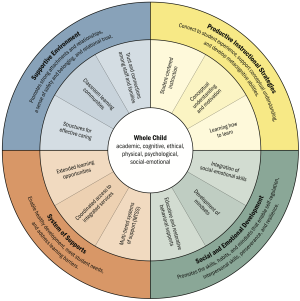
Beyond just teaching academics, schools can foster students’ development in their relationships, identity, emotional skills, and overall well-being.
By Lisa Flook | April 23, 2019 BookmarkCurrently, our education system often focuses on a narrow sliver of children’s cognitive development with an emphasis on transmitting content knowledge, often to be memorized and repeated in the same form it was received. Lessons in math, science, and reading—and tests in those skills—dominate the curriculum.
While those subjects are fundamental, learning involves far more than merely acquiring inert knowledge in algebra or chemistry. Such a narrow focus gives short shrift to the ways that children need to grow and learn in their relationships, identity, emotional understanding, and overall well-being. After all, children are multi-dimensional “whole” beings whose development is complex and rich.
Recent research in neuroscience, developmental and learning sciences, education, sociology, and many other fields confirms that a “whole child” approach is not only desirable but necessary to ensure that children learn well. According to two comprehensive reviews of the science on children’s development and learning:

At the Learning Policy Institute, as part of a new initiative on the Science of Learning and Development, we synthesized these scientific findings to identify how schools can best promote child development. We identified four main ingredients of school success that allow us to care for and nurture the potential in all children: a positive school climate, productive instructional strategies, social-emotional development, and individualized supports. Here’s what we’ve learned so far about why these ingredients are meaningful and how to put them into action.

Four main ingredients allow schools to best promote whole child development.
In a recent national survey, only 30 percent of high school students rated their school culture positively. Many schools today are based on antiquated designs from the early 1900s that emulate the factory model, wherein students cycle through classrooms and teachers see hundreds of students a day. These structures depersonalize learning at a time when students need and would benefit from long-term relationships with teachers and peers.
Creating a positive school climate based on strong relationships provides a bedrock for learning. Students need to feel a sense of safety and belonging in order to thrive in school. Some elements that promote a sense of community and allow teachers to know their students well include:
For example, one way to help students feel that they belong is to engage students in developing their own shared classroom norms that are posted and regularly referred to, and to assign classroom tasks so that each student is involved in supporting the community. Teachers can also aim to convey high expectations and provide adequate supports for all students, sending the message that they’re capable. This is especially important for students who have received mixed or discouraging messages about their ability from adults in the past, whether due to explicit or implicit biases.
A variety of other practices can help build a sense of community. Community walks, in which students lead tours of the neighborhoods surrounding their school, can help build cultural competence among educators as they learn more about students’ lives outside of school. Planning meetings that include educators across subjects and departments, and professional development to support educators’ own social-emotional competencies and well-being, can help educators collaborate and develop trust.
Overall, a positive school climate aims to foster deeper relationships among adults and students to promote a sense of safety and belonging, which are conducive to learning.
In focus groups and interviews with students who had dropped out of high school in 25 urban, suburban, and rural communities, nearly half (47 percent) said a major reason for dropping out was that classrooms were not interesting. These young people reported being bored and disengaged from high school. Even among those who stayed in school, 81 percent said that there should be more opportunities for real-world learning.
Students crave opportunities to learn things that matter and are relevant to their lives. Instruction helps students grow in their understanding when it builds on students’ prior experience and scaffolds learning by meeting them where they’re at. For example, teachers can connect lessons in mathematics to common tasks students are engaged in that use those skills, such as in cooking, artwork, sports, and other settings. Or they can connect a history unit on the Civil Rights movement to modern-day issues like the racially motivated attacks in Charlottesville and police brutality against people of color.
When skillfully combined with direct instruction, inquiry-based learning that is driven by students’ interests boosts their motivation and develops real-world skills. In one middle school class in Oakland, for example, students decided to study how environmental pollution affects the ocean and then designed a campaign to reduce waste and litter and increase recycling at their school. These projects teach valuable skills of collaboration, problem solving, and organization, and have a tangible impact.
Assessments that include feedback and opportunities to revise work help students learn how to learn and encourage an intrinsic desire to understand the material and challenge themselves, beyond just making the grade. This type of “mastery-oriented approach” is associated with more meaningful learning. For example, some schools cultivate student inquiry and revision skills through capstone projects—yearlong research projects—that give students an opportunity to learn deeply about an issue that matters to them and, often, work to create change in their own community. These projects are usually revised to meet a high standard of inquiry and presented to panels of educators and other adults from outside the school, like a dissertation defense.
Students’ control over their own education is also supported by practices like student-led conferences, which allow students to regularly share their work with parents and teachers and reflect on their learning and goals.
Far from being boring, effective instructional strategies connect learning to students’ lives, and empower them to use their knowledge for their own and others’ benefit.
Students in the U.S. report feeling stressed at school 80 percent of the time. When students are overwhelmed, they are more likely to act out and have difficulty adjusting at school. Indeed, children in U.S. public schools lost more than 11 million instructional days due to suspensions in a single school year.
Developing students’ social-emotional skills teaches them how to manage stress, while also boosting social skills like collaboration and empathy. In this way, social-emotional skills involve developing greater awareness of oneself and others. Many schools teach these skills explicitly through programs of social-emotional learning, which have been found to improve students’ achievement, as well as their feelings of safety and belonging at school.
In addition, to reduce suspensions and other punitive discipline in schools, schools are using restorative practices—like “circles” and peer mediation—which teach students to take responsibility and repair harm done in their relationships. A restorative approach is grounded in students recognizing and valuing their role and responsibilities within the community. Ultimately, restorative practices serve to build individual skills and cultivate a stronger community while also boosting student achievement and graduation rates.
Not all children have the material and social capital that affords access to high-quality learning environments and experiences. For example, high-income parents increased their spending on “enrichment activities” for their children, like tutoring and extracurricular activities, by 151 percent over the past several decades, compared to 57 percent for low-income parents. These differentials augment the achievement gap between affluent and low-income students.
Additional supports are also needed for the growing number of children who experience adversity in the form of poverty, homelessness, food insecurity, learning obstacles, or lack of health care. Schools need a flexible system of supports to address these needs.
The community schools model is one in which public schools partner with families and community organizations to provide well-rounded educational opportunities and supports for students’ school success. It typically includes before- and after-school enrichment, such as mentoring and academic support, as well as summer learning opportunities, like workshops on film and art, sports camps, and long-distance trips to visit college campuses. Some schools partner with local organizations and university staff to offer immersion experiences where students learn from professionals through internships or workshops on topics of interest, like technology, film, and art.
In addition, through partnerships with community organizations, schools offer health, mental health, and social services to help students overcome barriers to learning. A social worker or community liaison typically coordinates these services. Some schools partner with university programs, as well as health and mental health providers, to bring trainees (like psychology students) into the school as support staff.
These kinds of support reflect a whole school approach to whole child development that maximizes opportunities for all children to succeed.
Combined, these four ingredients are essential parts of a comprehensive framework that, in practice, build on and reinforce each other. A wealth of research demonstrates that successful education cannot happen in a piecemeal fashion. Taking an integrated approach can help children, with all their complexity and humanity, to develop to their full potential.

Greater Good wants to know: Do you think this article will influence your opinions or behavior?